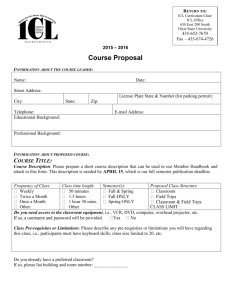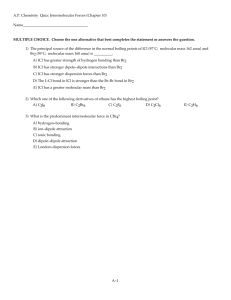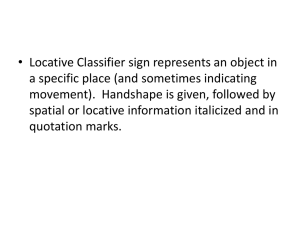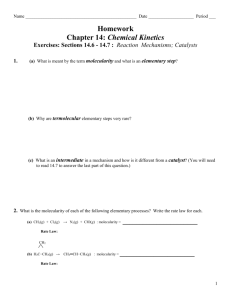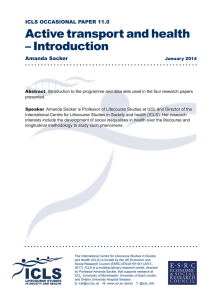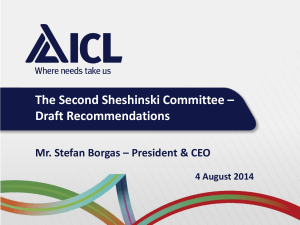n - Conferences
advertisement
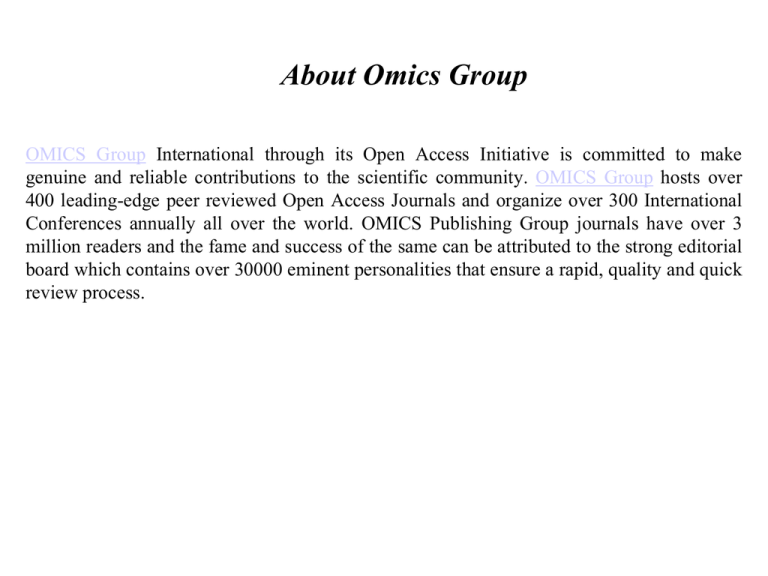
About Omics Group OMICS Group International through its Open Access Initiative is committed to make genuine and reliable contributions to the scientific community. OMICS Group hosts over 400 leading-edge peer reviewed Open Access Journals and organize over 300 International Conferences annually all over the world. OMICS Publishing Group journals have over 3 million readers and the fame and success of the same can be attributed to the strong editorial board which contains over 30000 eminent personalities that ensure a rapid, quality and quick review process. About Omics Group conferences • • OMICS Group signed an agreement with more than 1000 International Societies to make healthcare information Open Access. OMICS Group Conferences make the perfect platform for global networking as it brings together renowned speakers and scientists across the globe to a most exciting and memorable scientific event filled with much enlightening interactive sessions, world class exhibitions and poster presentations Omics group has organised 500 conferences, workshops and national symposium across the major cities including SanFrancisco,Omaha,Orlado,Rayleigh,SantaClara,Chicago,Philadelphia,United kingdom,Baltimore,SanAntanio,Dubai,Hyderabad,Bangaluru and Mumbai. HIGH-EFFICIENCY INTERBAND CASCADE LASERS 2nd International Conference on Lasers, Optics, and Photonics Philadelphia, PA, Sept. 8, 2014 Charles D. Merritt, William W. Bewley, Chul Soo Kim, Chadwick L. Canedy, Joshua Abell, Igor Vurgaftman, & Jerry R. Meyer Naval Research Lab, Washington DC 20375 [MWIR_lasers@nrl.navy.mil] Mijin Kim Sotera Defense Solutions, Crofton MD 21114 3 DISTINCT WAYS TO PROVIDE CARRIERS FOR POPULATION INVERSION n p (1) Conventional Diode Laser (2) Quantum Cascade Laser n n n n n p n p (3) Interband Cascade Laser n p n Hybrid of conventional diode (Interband active transitions) & QCL (Cascaded stages) THE INTERBAND CASCADE LASER "W" 2.5 Active Electron Injector Hole Injector InAs AlSb 2.0 CB Energy (eV) 1.5 InAs 1.0 GaSb 0.5 0.0 -0.5 GaInSb -1.0 0 Semimetallic Interface 100 200 VB 300 400 500 Distance (Å) 1st Proposed: R. Q. Yang (1994) Design Improvements: NRL (1996) 1st Experimental Demo: U. Houston & Sandia (1997) Further Development: ARL, Maxion, JPL, U. Oklahoma, U. Würzburg, Nanoplus, U. St. Andrews RT cw operation: NRL (2008) REBALANCING EFFECT ON THRESHOLD Heavily n-Doped -3 18 Injector QWs (5 x 10 cm ) 2.5 10000 2.0 W-Diode CB ICLs 150 m x 2 mm T = 300 K = 2.9-4.0 m 1.5 2 Pulsed jth (A/cm ) 19 -3 Energy (eV), n, p (10 cm ) [Vurgaftman et al., Nature Com. 2, 585 (2011); U.S. Patent Application 13/422,309 (2012); International Patent Application PCT/US12/29396 (2012)] 1.0 0.5 n 0.0 p -0.5 10-Stage Best 30-40 Stage QCL 60-Stage QCL 1000 Gen3 VB RT CW -1.0 0 100 200 300 400 500 600 Distance (Å) Major performance breakthrough with “carrier rebalancing”, via heavy n-doping of electron injectors, to roughly equalize electron & hole populations in active region Gen2 Gen1 5-Stage (Gen0) 100 2005 2007 Carrier Rebalancing 2009 2011 2013 Year Dramatic threshold reduction compared to all previous ICLs ICL SPECTRAL RANGE & LOW DRIVE POWER Threshold power density: Pth = Vth x jth [Vurgaftman et al., Nature Com. 2, 585 (2011)] 100 12 CW Output Power (mW) 2 Pulsed Pth (kW/cm ) 50 QCLs 20 10 T = 300 K 5 2 NRL 5-Stage Gen3 ICLs 1 0.5 0.2 3.5 4.0 4.5 5.0 5.5 Wavelength (m) Power density thresholds 30x lower than record QCL results CW operation to T = 48 °C @ = 5.7 m HR/Uncoated T = 25 °C 8 6 w = 5 m 8 m 11 m 4 2 0 3.0 Lcav = 0.5 mm 10 0 20 80 60 40 Input Power (mW) 100 T = 25 °C: Input for lasing < 30 mW Best QCL result: 700 mW Critical for battery-operated, hand-held, solar-powered, etc. DFB ICLs Grown, processed, & tested @ NRL: Grating etched into deposited Ge [Kim et al., APL 101, Normalized Spectral Intensity 061104 (2012)] I = 170 mA 1 Grown @ NRL; Processed & tested @ JPL: 2nd-order side grating yields single mode o o 65 C 45 C [Forouhar, et al., to be published] o o 35 C o o 55 C T = 25 C 75 C 0.1 0.01 [von Edlinger et al., PTL 26, 480 (2014)] 1E-3 3.78 3.79 3.80 Wavelength ( m ) 3.81 Single-mode tuning with temp: 21.5 nm with current: 10 nm 3 o Voltage (V) 40 C = 531 nm 7.4 m x 2 mm HR/AR 2 50 40 30 o 60 C 20 1 Power (mW) o 40 C o 80 C 10 o 75 C 0 o 80 C 0 100 200 300 400 0 Current (mA) Poutcw = 27 mW @ T = 40 ºC, 1 mW @ 80 ºC Threshold drive power = 280 mW @ 40 ºC Poutcw = 18 mW @ T = 46 ºC Threshold drive power < 400 mW @ 36 °C Lifetime testing: > 10,000 hrs. cw operation @ 40 °C with negligible degradation EPI-DOWN MOUNTING: HIGHER Tmaxcw [Bewley et al., Opt. Expr. 20, 20894 (2012); U.S. Provisional Patent Application 61611800 (2012)] 400 118C Type-II Mid-IR Lasers CW Tmax (K) 350 Gen1 Gen0 300 JPL/OU JPL Maxion /UMD With NRL carrier rebalancing 50 0 Maxion NRL ICLs Maxion 200 Maxion/NRL Room Temperature 250 Würzburg 100 °C Gen3 -50 W Diode (NRL MBE) W Diode (Sarnoff MBE) 2000 2004 2008 Year 2012 -100 CORRUGATED-SIDEWALL ICLs Lateral Mode Profiles 3 [Bewley et al., Opt. Expr. 20, 20894 (2012)] 2 Ridge 40 °C 60 °C 2 80 °C 50 100 °C 0.2 0.4 0.6 0.8 105 °C 1.0 1.2 Current (A) Pmaxcw > 200 mW @ T = 25 ºC (M2 = 1.6) I = 400 mA (M = 1.3) 800 (1.5) 1200 (1.6) Normalized CW Far Field Output Power (mW) 5-Stage ICL Corrugated SW Epi-Down (HR/AR) 150 18.2 m x 4 mm = 3.7-3.9 m 100 0 0.0 1 T = 25 °C 200 -40 -20 0 Angle (°) Corrugated SW 18.2 m x 4 mm HR/AR T = 25 °C 20 Wider ridge (25.1 m): 305 mW (M2 = 2.2); WPE = 6.6% @ Pmax 40 TAPERED ICLs [Bewley et al., APL 103, 111111 (2013)] 3 200 Device A o T = 25 C 1 0 0.0 0.5 1.0 1.5 Current (A) 100 2.0 0 Tapered ridge with no straight section CW Farfield Intensity (Normalized) 300 2 CW Power (mW) Voltage (V) 400 T120606 HR/AR 0mm x 5m + 4mm @ HA=0.42° I(mA) 500 750 1000 1250 1500 1750 2000 CW T = 25 °C -15 -10 -5 0 Angle (°) Pmaxcw (25 ºC) = 403 mW (M2 = 2.3), WPE = 7.0% @ Pmax 5 Pout(mW) 63 138 207 265 310 342 359 10 15 TO FURTHER ENHANCE POWER & BRIGHTNESS: INCREASE EFFICIENCY Ext Diff QE/Stage (2 Facets, %) As of October 2012: 40 ICLs 150 m x 2 mm T = 300 K Gen3 30 Gen1 20 Gen0 10 0 Gen2 3.0 3.5 4.0 4.5 5.0 5.5 Wavelength (m) Try varying other parameters in rich ICL design space, e.g.: • Thicker n-GaSb separate confinement layers (SCLs), for lower mode overlap with active & clad, hence reduced loss • More active stages (e.g., 7 vs. 5), for higher slope efficiency & gain Top Contact Top Clad SCL Active QWs SCL Bottom Clad Substrate Diff Slope Eff (mW/A per Facet) FIRST 5 STAGES WITH THICKER SCLs 5-Stage ICLs = 3.2-3.8 m 150 m x 2 mm Pulsed 600 400 5-Stage SCL = 500 nm 200 SCL = 700-800 nm 0 300 320 340 360 Temperature (K) 380 Thick SCLs increase efficiency at 300 K, but fail to provide enough gain at high T 7 STAGES Diff Slope Eff (mW/A per Facet) [Bewley et al., Opt. Expr. 22, 7702 (2014)] 600 7-Stage 5- & 7-Stage ICLs = 3.2-3.8 m 150 m x 2 mm Pulsed 400 5-Stage 200 0 300 320 340 360 Temperature (K) 380 Thick SCLs increase advantage at 300 K, while retaining sufficient gain at high T Even better news: Slope7/Slope5 > 7/5 indicates lower loss! EXTERNAL DIFFERENTIAL QUANTUM EFFICIENCY Result is significantly higher EDQE: Ext Diff QE/Stage (2 Facets, %) 60 50 Gen3B (7-Stage/Thick SCL) 40 Gen3 NRL ICLs 150 m x 2 mm T = 300 K Pulsed 30 Gen2 20 10 Gen1 Gen0 0 3.0 3.5 4.0 4.5 5.0 5.5 Wavelength (m) 7-stage ICLs with thick SCLs (Gen3B) exhibit higher EDQE & lower loss at all CW POWER & FAR FIELD PROFILE 5 300 3 200 100 0 0 200 7-Stage ICL CH4 Etch 2 Epi-Down, HR/AR 22.0 m x 3 mm o T = 25 C 1 400 600 0 800 7-Stage ICL, CH4 Etch Farfield Intensity (Arb. Units) 4 Voltage ( V ) Power (mW) 400 Epi-Down, HR/AR 22.0 m x 3 mm o T = 25 C I = 750 mA 2 (M = 2.6) 500 (2.3) -40 Current (mA) -20 0 Angle (°) Pmaxcw = 384 mW in high-quality beam (M2 = 2.6) WPE = 12.4% 20 40 [Bewley et al., Opt. Expr. 22, 7702 (2014)] CW Wallplug Efficiency (%) WIDER RIDGE (w = 32 m) 15 7-Stage ICL (32.4 m x 3 mm) 10 5-Stage ICL (25.2 m x 4 mm) 5 T = 25 oC Corrugated Sidewalls 0 0 500 1000 1500 Current (mA) T = 15 C o 25 C Epi-Down, HR/AR 32.4 m x 3 mm o 35 C 400 o 45 C o 55 C 200 o 65 C Wallplug Efficiency (%) Power (mW) 600 7-Stage ICL, 32.4 m x 3 mm o 7-Stage ICL CH4 Etch 15 o T = 15 C o 25 C o 35 C 10 o 45 C o 55 C 5 o 65 C o 70 C o 70 C 0 0 0 200 400 600 800 Current (mA) 1000 1200 1400 0 200 400 600 800 1000 1200 1400 Current (mA) Pmaxcw up to 592 mW (WPE = 10.1%, M2 = 3.7) @ 25 C; 696 mW (11.7%) @ 15 C LATEST RESULTS: 10 STAGES ( = 3.45 m) 500 400 w = 22 m 300 200 5 100 0 0.0 0.2 0.4 0.6 Current (A) 0.8 1.0 0 Farfield Intensity (a.u.) 10 T = 25 oC 10-Stage ICLs Epi-Down, HR/AR Facets Lcav = 4.5 mm CW Output Power (mW) Wallplug Efficiency (%) 15 10-Stage ICL 22 m x 4.5 mm I = 0.960 A 2 (485 mW, M = 2.5) I = 0.76 A 2 (404 mW, M = 2.2) I = 0.56 A 2 (289 mW, M = 1.9) -30 -20 -10 0 10 Angle (degrees) Also: Pmaxcw = 464 mW (WPE = 11%, M2 = 1.9) @ 25 C 20 30 RECORD ICL WALLPLUG EFFICIENCIES 20 T = 25 oC 10-stage ICL Lcav = 1 mm Epi Down, HR/AR 0 0.00 0.05 0.10 Current ( A ) 0.15 CW WPE (%) CW WPE (%) 15 5 200 15 150 15 m w = 12 m 10 20 0.20 10 o T = 25 C 7-Stage ICLs Lcav = 1 mm 5 0 0.00 w = 12 m w = 15 m 0.05 0.10 0.15 Current (A) CW WPEs for 4 devices from 2 wafers (7-Stage & 10-Stage): ≈18% 100 50 0 0.20 CW Output Power (mW) With much shorter 1 mm cavity: SUMMARY: CW POWER & BRIGHTNESS Year Stages (m) ai -1 (cm ) Ridge Mount Lcav (mm) width (m) Pmax25C (mW) WPE(Pmax) (%) M2 2008 5 3.75 12.2 Straight Epi-Up 3 9 10 0.7 ≈2 5 2009 5 3.67 6.6 " " 3 10 59 3.1 ≈2 30 2011 5 3.57 6.9 " " 3 11 158 9.9 3 53 2012 5 3.66 4.5 Straight Epi-Down 4 11 198 7.1 1.8 110 Corrug. " " 25 305 6.5 2.2 139 Brightness 2 (Pmax/M ) 2013 5 3.72 5.2 Tapered " 4 5 - 63 403 7.0 2.3 175 2014 7 3.45 3.0 Corrug. " 3 28 522 10.3 3.1 168 10 3.45 3.4 Corrug. " 4.5 18 464 11.2 1.9 245 7 3.11 3.3 Corrug. " 4.5 18 326 6.9 1.3 243 QCL vs. ICL • • • QCLs much more widely studied & matured, provide very high cw output powers ICLs provide much lower power dissipation, possibility for vertical emission, & minimal beam steering – also less mature, so more room for improvement = 3-4 m: ICLs generally preferred – QCLs now produce Pmaxcw > 1 W @ RT, but higher threshold, lower efficiency, & questionable yield thus far • = 4-6 m: QCL sweet spot for high power (Up to 5 W cw demonstrated) – But ICL still preferred in applications requiring low power from ultra-compact battery-operated package (e.g. laser spectroscopy) • = 2.5-15 m LEDs: Only ICLs suitable for top emission • = 6-150 m Lasers: QCLs preferred (so far, high loss in ICLs) • QCLs & ICLs can complement each other throughout mid-IR Let Us Meet Again We welcome all to our future group conferences of Omics group international Please visit: www.omicsgroup.com www.Conferenceseries.com http://optics.conferenceseries.com/
